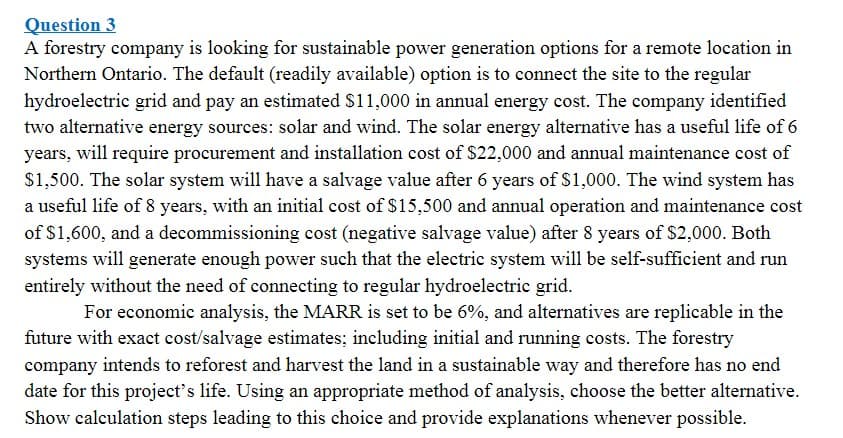rthern Ontario. The default (readily available) option is to connect the site to the regular Iroelectric grid and pay an estimated S11,000 in annual energy cost. The company identif alternative energy sources: solar and wind. The solar energy alternative has a useful life rs, will require procurement and installation cost of $22,000 and annual maintenance cos 500. The solar system will have a salvage value after 6 years of S1,000. The wind system seful life of 8 years, with an initial cost of $15,500 and annual operation and maintenance $1,600, and a decommissioning cost (negative salvage value) after 8 years of $2,000. Bot tems will generate enough power such that the electric system will be self-sufficient and: irely without the need of connecting to regular hydroelectric grid. For economic analysis, the MARR is set to be 6%, and alternatives are replicable in ure with exact cost/salvage estimates; including initial and running costs. The forestry
rthern Ontario. The default (readily available) option is to connect the site to the regular Iroelectric grid and pay an estimated S11,000 in annual energy cost. The company identif alternative energy sources: solar and wind. The solar energy alternative has a useful life rs, will require procurement and installation cost of $22,000 and annual maintenance cos 500. The solar system will have a salvage value after 6 years of S1,000. The wind system seful life of 8 years, with an initial cost of $15,500 and annual operation and maintenance $1,600, and a decommissioning cost (negative salvage value) after 8 years of $2,000. Bot tems will generate enough power such that the electric system will be self-sufficient and: irely without the need of connecting to regular hydroelectric grid. For economic analysis, the MARR is set to be 6%, and alternatives are replicable in ure with exact cost/salvage estimates; including initial and running costs. The forestry
Managerial Economics: Applications, Strategies and Tactics (MindTap Course List)
14th Edition
ISBN:9781305506381
Author:James R. McGuigan, R. Charles Moyer, Frederick H.deB. Harris
Publisher:James R. McGuigan, R. Charles Moyer, Frederick H.deB. Harris
Chapter17: Long-term Investment Analysis
Section: Chapter Questions
Problem 10E
Related questions
Question

Transcribed Image Text:Question 3
A forestry company is looking for sustainable power generation options for a remote location in
Northern Ontario. The default (readily available) option is to connect the site to the regular
hydroelectric grid and pay an estimated S11,000 in annual energy cost. The company identified
two alternative energy sources: solar and wind. The solar energy alternative has a useful life of 6
years, will require procurement and installation cost of $22,000 and annual maintenance cost of
$1,500. The solar system will have a salvage value after 6 years of $1,000. The wind system has
a useful life of 8 years, with an initial cost of $15,500 and annual operation and maintenance cost
of $1,600, and a decommissioning cost (negative salvage value) after 8 years of S2,000. Both
systems will generate enough power such that the electric system will be self-sufficient and run
entirely without the need of connecting to regular hydroelectric grid.
For economic analysis, the MARR is set to be 6%, and alternatives are replicable in the
future with exact cost/salvage estimates; including initial and running costs. The forestry
company intends to reforest and harvest the land in a sustainable way and therefore has no end
date for this project's life. Using an appropriate method of analysis, choose the better alternative.
Show calculation steps leading to this choice and provide explanations whenever possible.
Expert Solution
This question has been solved!
Explore an expertly crafted, step-by-step solution for a thorough understanding of key concepts.
Step by step
Solved in 2 steps

Recommended textbooks for you

Managerial Economics: Applications, Strategies an…
Economics
ISBN:
9781305506381
Author:
James R. McGuigan, R. Charles Moyer, Frederick H.deB. Harris
Publisher:
Cengage Learning

Managerial Economics: Applications, Strategies an…
Economics
ISBN:
9781305506381
Author:
James R. McGuigan, R. Charles Moyer, Frederick H.deB. Harris
Publisher:
Cengage Learning